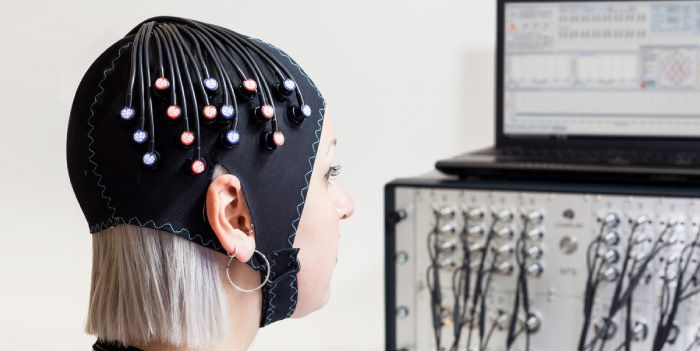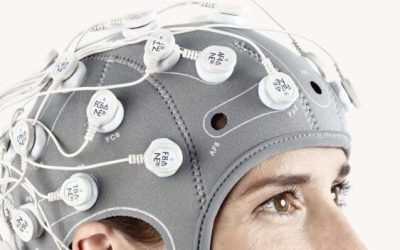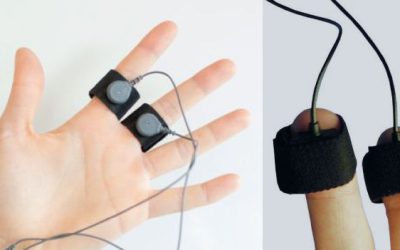In recent years, the growing interest of the neuroscientific community for the Functional near-infrared spectroscopy (fNIRS) has grabbed the attention of neuromarketing experts.
Functional near-infrared spectroscopy (fNIRS) is a non-invasive optical imaging technique that measures blood oxygenation changes similar to fMRI.
Such changes in hemoglobin (Hb) concentrations within the brain can be measured by means of the characteristic absorption spectra of Hb in the near-infrared range.
What is the difference between fNIRS and fMRI?
The fMRI (Functional magnetic resonance imaging), well known for its advantages like the high and very detailed spatial resolution, shows a serious limitation when the researcher needs to deal with real-world applications.
Is it possible to investigate the brain response to a product within a real environment like a supermarket or a point of sales by the use of the fMRI? Is it possible to explore the brain response of consumers while they are interacting with a website or a mobile app by the use of the fMRI?
The answer to both questions is… unfortunately no.
Regardless the costs of an fMRI experiment that are currently still extremely high, the experimental setup requires the total immobility of subjects. The participants of a fMRI experiment cannot move at all. They need to lie down inside the scanner, that most of the time is located inside a hospital. In this direction, another aspect to take into account is that most of the companies and academics operating in the field of neuromarketing and consumer neuroscience don’t own a fMRI, instead they have special agreement with public and private institutes operating in the healthcare industry.
Nevertheless, “whenever a limitation cannot be overcome, a new product is born”: the Functional near-infrared spectroscopy (fNIRS).
The advantages of using the Functional near-infrared spectroscopy (fNIRS)
The growing interest of neuromarketing experts for the Functional near-infrared spectroscopy (fNIRS) is mainly based on the following reasons:
- Movement: the experimental subjects recruited for a neuromarketing research can freely move.
- Portability: it is really easy to carry in different contexts of study.
- Low cost: the price of the fNIRS is definitely lower than other neuroimaging techniques like the Functional Magnetic Resonance Imaging (fMRI)
- Real-time: if needed, fNIRS can be used to assess regional oxygenation in real–time.
- Temporal Resolution: fNIRS, compared to other neuroimaging techniques, has a higher temporal resolution (up to 100 Hz, even if usually 1–10 Hz). However, it is important to mention that its temporal resolution is still not comparable to other techniques widely use in the neuromarketing field, such as the Electroencephalography (EEG), that is capable to capture neural events in the order of milliseconds.
fNIRS in Neuromarketing

Nowadays neuromarketing experts are highly attracted by the efficient cost-utility trade-off of the Functional Near-Infrared Spectroscopy (fNIRS) in order to monitor cognitive and affective states. In the next future, its application in the neuromarketing field, with the aim to improve advertising materials, digital products and the customer experience in real and virtual environment, will become extremely common.
In 2018, Lee et al. already highlighted the advantages of the fNIRS in Neuromarketing, proposing its integration among the most effective neuromarketing methods. In response to Lee et all, a study including two small fNIRS experiments demonstrated the great opportunities that lie behind the fNIRS application in the neuromarketing field. in particular, the authors of the study shared the following highlights:
- Significant differences in activation of prefrontal cortex between different tested stimuli
- Higher activation viewing labels and brands compared to non-labeled products
- Significantly higher activation when in drinking cola compared to just viewing a picture situations
Such results, along with the growing number of studies related to the application of fNIRS in the neuromarketing field, demonstrated the feasibility and high potential of mobile fNIRS in such commond ground, where neuroscience meets marketing.
fNIRS in Human Factors and Clinical Applications

Beyond the neuromarketing field, the fNIRS is nowadays widely applied in the following contexts:
- Safety simulations, training, and monitoring for airline pilots, train and mass transit engineers, ship captains, truck drivers, crane and other heavy-equipment operators, and air traffic controllers
- Military simulations and training
- In-home, real-time monitoring and feedback during patient rehabilitation for cognitive impairment or depression
- Replacement for or supplement to functional brain imaging











